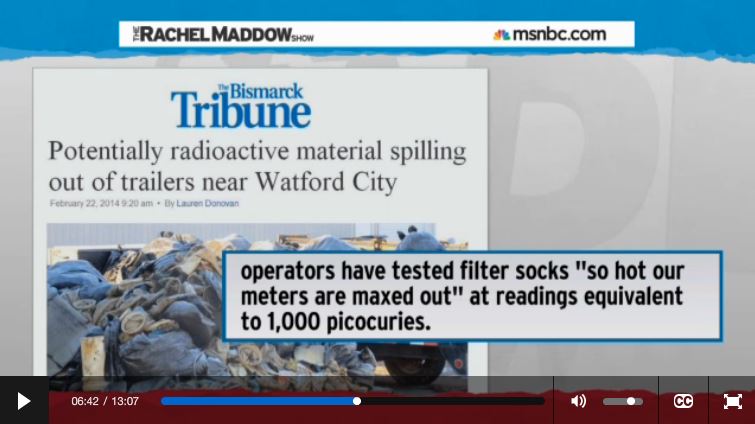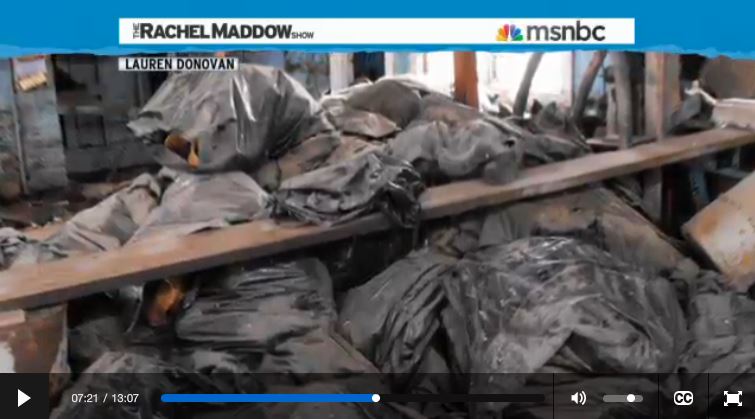“What will they do with all the frac waste?” people asked Ernst on her speaking tours.”They will make us eat and drink it,” Ernst replied. (And later we find out: drive, walk, run, bike on it)
Radioactive fracking waste could end up in Missoula landfill by Laura Lundquist, Oct 26, 2019, KPAX.com
MISSOULA — The state of Montana could decide to allow significant amounts of radioactive fracking waste in local landfills, and some of it could end up in Missoula’s backyard.
This week, the state Department of Environmental Quality closed its comment period on a new limit for the amount of technologically enhanced radioactive material, called TENORM, that landfills can accept.
DEQ wants to set the radiation limit at 200 picocuries per gram of two variants, or isotopes, of radium. But that is four times what the agency proposed back in August 2017 and four times more than any other state allows, including North Dakota, home of the Bakken oil fields.
DEQ officials say they’ll take about the next six months to decide what to do.
Public health and environmental groups are questioning why the agency is proposing such a large jump, especially because most TENORM waste comes from North Dakota.
Common items emit some radiation but at very low levels, including bananas and brazil nuts at about 5 pCi/g and coffee and granite countertops at 27 pCi/g. Naturally occurring radioactive material, or NORM, includes certain naturally radioactive ores extracted from mines, and those are regulated above certain limits.
However, fracking pulls similar radioactive particles from deep in the earth and concentrates them, increasing their intensity, so it’s considered technologically enhanced or TENORM.
Different parts of the fracking process end up being more radioactive than others. Filter devices called “socks” separate mineral sludge from the fracked oil or gas, so socks and sludge develop a highly concentrated radioactivity level, according to the Western Organization of Resource Councils .
That’s why the Coral Creek Landfill near Baker accepts TENORM waste but refuses to take socks because they “always exceed the analytical limits” for radioactivity. This and other more highly radioactive material ends up in radioactive waste repositories.
While TENORM currently is more of an eastern Montana concern, Missoula’s Republic Services is one of four landfills in the state that has a permit to accept radioactive fracking waste, although it has yet to do so.
In 2016, David Seeberger of Republic Services said he was looking forward to the new TENORM rules and that a new landfill glass flare system had been installed at the Missoula landfill, according to DEQ Solid Waste Advisory Committee minutes .
Even though it’s across the state from North Dakota, Missoula could receive TENORM waste shipped by rail. In 2017, Robert Sochovka of the Cornerstone Environmental Group wrote: “As waste exporting states find it more difficult to transport trash longer distances, the industry is looking to rail service to move its material more economically.”
The Missoula Current made multiple calls to Donald Moss, the acting general manager who replaced Glenda Bradshaw, asking if Republic Services would accept fracking TENORM at Missoula’s landfill, and to what level. None of the calls were returned.
Why is DEQ trying to create a TENORM limit?
Fracking is a relatively new thing, and oil and gas companies started moving TENORM waste around before any regulations were developed.
Once the Environmental Protection Agency was finally forced by a 2016 lawsuit to address the issue, it stalled.
Under the Trump administration, the EPA has now refused to set limits , announcing in May that it would leave fracking TENORM regulation up to the states.
That’s resulted in a patchwork, from states that take varying levels of TENORM to those that refuse to take any.
If Montana ups its level to 200 pCi/g, it would allow the highest radiation levels of any state, and some are predicting that would cause even more waste to flow into the Treasure State.
But that’s what some people want.
In 2014, Ross Oakland, former owner of Oaks Disposal near Glendive, complained that before he opened his facility in 2013, Montana was losing business because all of North Dakota’s waste was being sent to Colorado or Idaho.
Oaks Disposal was the one facility certified to accept the highest amount of radiation – currently 50 pCi/g – and North Dakota wasted no time taking advantage of it. Now, almost 80% of the TENORM at Oaks Disposal – now owned by a Colorado company – comes from North Dakota.
The only problem is nearby residents are reporting problems with their water.
DEQ’s quarterly tests showed the groundwater has had “significant increases” in chloride and radium, although the levels are still acceptable. So DEQ required Oaks Disposal to increase the size of its storm ponds to prevent overflow and runoff into the groundwater.
Groundwater contamination is one of the main issues with TENORM waste. And in Missoula, that could be a significant concern, as the public water supply comes from a single-source aquifer that runs beneath the valley.
That’s why the Northern Plains Resource Council commended the DEQ for proposing that groundwater be tested by an independent party. But the organization argued against DEQ allowing landfills to do their own environmental monitoring and not requiring storm water ponds to be lined. And even North Dakota requires thicker landfill liners.
***
Leaky Liner Reality Check:
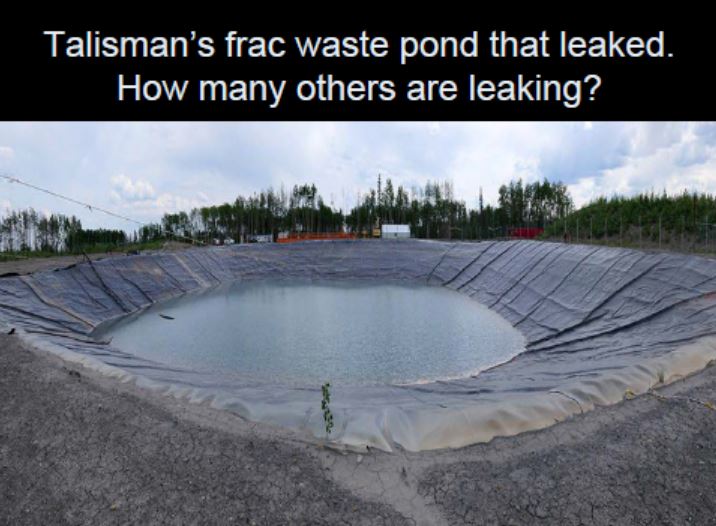

Photos by Will Koop of “lined” frac pits in NEBC
End Leaky Liner Reality Check
***
But it’s the 200 pCi/g limit that bothers the Northern Plains Resource Council, Montana Environmental Information Center and others the most.
In addition to groundwater contamination, radiation is a safety concern for landfill workers. For them, the risk of radiation increases if they inhale TENORM dust, and lung cancer is a primary associated hazard. But a 2016 Argonne National Laboratory study found a landfill limit of 50 pCi/g is “likely to be protective,” keeping workers from exceeding the annual public safety limit of 100 millirems of radiation as long as a worker spends only half of their work time on site.
But how can they work if the TENORM level becomes four times greater? [Get Ex CEO of Encana, Gwyn Morgan to do the work or ex Manager of Encana, Mark Taylor, who recently “left” the AER. Or Hanky Panky ex AER CEO Jim Ellis.]
“It’s really an understudied issue,” said Yale University epidemiologist Nicole Deziel.
“The (fracking) industry took off before health impacts were studied. [industry and regulators knew that was the only way the industry could take off.] That’s pretty common with environmental exposure problems. But an absence of data doesn’t equate to an absence of risk.”
Deziel has conducted reviews of health problems related to living near fracking facilities and found 25 of 29 studies that show some adverse effect. But scientists have looked for related health issues only since 2013, so most studies were initiated at least a decade after the start of modern fracking. [Frac polluters do not want true “baseline” data. All frac harm monitoring started a decade or more after the impacts with most industry and regulatory “experts” calling the data from such monitoring “baseline.”]
Scientists have investigated little related to the indirect effects of fracking, such as radiation issues from waste. It may be another decade before any related health or environmental problems appear from that, if limits keep increasing.
DEQ was getting ready to finalize a 50 pCi/g limit in August 2017.
Why is it now so much more? [Because the oil and gas/frac industry and its enabling regulators know how radioactive the waste is]
As the process dragged out, DEQ never finalized the 50 pCi/g rule and was asked to increase the limit.
According to the minutes of the Solid Waste Advisory Committee, DEQ started revising the proposed rule after considering the 1,000 public comments received in September 2017. Six months later, members of the advisory committee asked to see the revised draft but were told they couldn’t see it until it was ready.
Then, in October 2018, the revisions were presented to the TENORM working group, which met at the Board of Oil and Gas building in Billings. The working group had originally proposed the 50 pCi/g limit in 2017. Some said they were notified of the change to 200 pCi/g just as a matter of courtesy.
So it’s not clear who proposed the higher radiation limit.
It could have been TENORM facility managers worried about having to compete if North Dakota ever certifies one of its landfills for TENORM. If both states have the same limit, Bakken producers are likely to prefer closer landfills.
North Dakota set its 50 pCi/g limit in 2016, but is only now getting around to permitting the first landfill near Williston. Part of the delay is due to pushback from neighbors and environmental groups worried about water runoff, similar to the worries of Montanans faced with an even higher radiation level.
But some say Montana’s higher limit was due to the influence of the oil and gas industry, specifically Montana Petroleum Association executive director Alan Olson.
Calls to Montana Petroleum Association spokesperson Jessica Sena were not returned by press time.
Calls to DEQ solid waste manager Rickhold Thompson were also not returned. But DEQ waste bureau chief Ed Thamke recently told Wastedive.com the limit wouldn’t be a problem because he expects loads exceeding 200 pCi/g would be rare and facilities will still need to maintain a 50 pCi/g average. The majority of loads coming to the Oaks facility in the last six years were below 50 pCi/g, according to Montana DEQ.
The Missoula Current has requested copies from DEQ of the public comments on the 2017 rule and minutes of the October 2018 working group meeting.
Refer also to:
‘Fracking brine’ Gas-well waste full of radium
Radium in one sample of Marcellus shale wastewater, also called brine, that Pennsylvania officials collected in 2009 was 3,609 times more radioactive than a federal safety limit for drinking water. It was 300 times higher than a Nuclear Regulatory Commission limit for industrial discharges to water. The December 2011 study, compiled by the U.S. Geological Survey, also found that the median levels of radium in brine from Marcellus shale wells was more than three times higher than brine collected from conventional oil and gas wells. “These are very, very high concentrations of radium compared to other oil and gas brines,” said Mark Engle, a U.S. Geological Survey research geologist and co-author of the report. State law bans radioactive shale-well sand and sludge from Ohio landfills.
North Dakota frac’d Bakken radioactive oilfield waste spilling out of trailers parked on rural land near Watford City: When the filter socks are “that orange color, we know they’re hot”
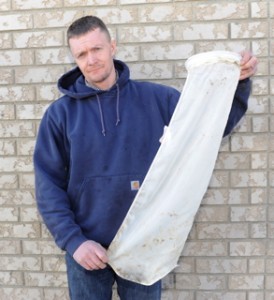
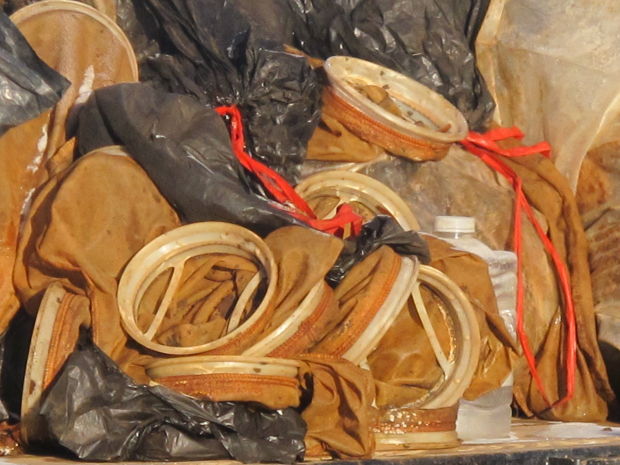
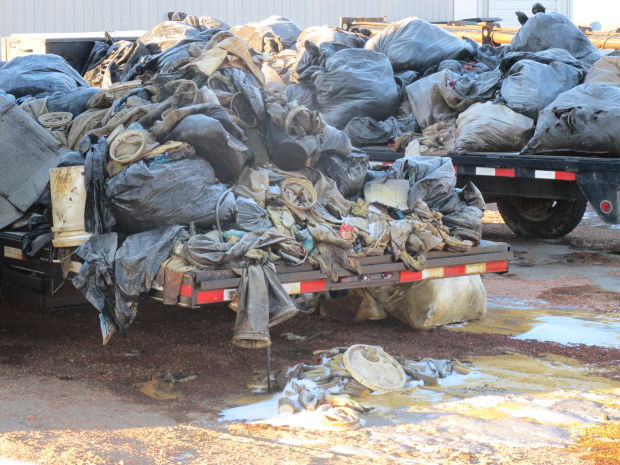
Rachel Maddow Show: illegal radioactive dump site found in remote North Dakota town, Noonan mayor angry over situation with radioactive filter socks
